#Petrus Borel
Text
ah that bit in every Romanticist bio where we gotta get the who's who as the author sees it (all this is from the Fourth Musketeer)
At the Café de Paris, on the boulevard, Alexander breathed the air of the great world. There the celebrities of journalism, literature, and dandyism met.
...this gets long
That man with the warlike hat and blinking eyes' is Nestor Roqueplan who has now left his garret, his washbasin-clock and his pistols-candelabra for the comfortable offices of the Figaro.
OK was this before/after/during its time as an anti-Romanticist paper??
Next him is Jules Janin, who looks comfortably rotund but thinks only of snapping at his neighbor, and who will later fight a duel with Dumas about a wretched question of dramatic criticism.
JULES JANIN DUELED ALEX DUMAS??
...JULES JANIN DUELES ALEX DUMAS AND LIVED?!?
That fellow by way of being a gentleman, dressed with the correctness of an English lord in a blue coat with gold buttons, a yellow waistcoat, and pearl-gray trousers, is the husband of Marie Dorval, Merle, one of the legitimist party, an epicure and an authority on gastronomy.
..wait, isn't that outfit a Werther cosplay? Am I getting the colors wrong?
. . Over at the long table, orating in a high voice, with his face awkwardly swathed in an enormous neckcloth to hide certain unpleasant scars, is Veron, nicknamed the Prince of Wales, actually the manager of the Revue de Paris, who pays Dumas royally, at least for the time being. With his high color, his greedy lips that look as if they were smeared with jam, and his gluttonous eyes, he seems at once an abbot of former times and a comedy valet.
This guy is way more important than you'd guess by how little he shows up in histories! Also he got his start in patent medicine, which is really jumping out at me post-Blue Castle read!
That tall, thin, dark man, with hair cut brush-shaped and a prominent nose, wearing a velvet caftan and a cap lined with martin fur, is Adolphe de Leuven, librettist of the Postillon de Lonjumeau, who launched Alexander. By his side, flaunting a magnificent kidskin waistcoat and whirling his rhinoceros cane, is handsome Roger de Beauvoir, with a mop of curly black hair, the only one of Alexander's friends who is an aristocrat of wealth-Beauvoir who entertains six hundred people at the Hôtel de Pimodan, and who has just challenged Balzac for accusing him of being named neither Roger nor Beauvoir. Although Balzac took the trouble to send him "forty pages of excuses," the dandy will listen to nothing and proclaims: "I scorn M. de Balzac's prose, I want only his skin!"
holy shit Balzac you messed up??
Here is Eugène Sue, very smart in his sea-green coat, with a rather vulgar turn of the nose that detracts from his good looks. Last, simpler and jollier than the rest, is that good fellow Méry who passes for a librarian at Marseilles, but who is always off on a lark to Paris; an amazing improviser who can compose correctly an act of a classical tragedy within two hours, and in the drawing-rooms describe the tortures of hell so vividly that the ladies beg for mercy.
Fun new party game: Describe the tortures of hell!
Near these gentlemen, but on a lower plane, the madmen appear. "He who was Gannot" and has made himself God under the name Mapah, is a fop and a billiard player now fallen on evil days who sends out manifestos signed "By Our Apostolic Ruin."
The Mahpah is one of the wildest ...visionaries? religious ...somethings? movement leaders? of the time, love seeing him get mentioned (Wiki) (Nonbinary wiki)
Jean Journet, called the Apostle, goes about dressed as a begging friar and sells his verses unfailingly entitled "Songs" or "Cries."
...I have no idea who this is . Sounds like he's coping with poverty very artistishly.
Poor Petrus Borel imagines himself to be a wolf; at his house Alexander has eaten cream from a skull. . . .
excuse you he never said he was a wolf
he said he was a werewolf
and no one actually disagreed
also man,you serve ice cream in skulls ONE time...
...you might see (Dumas) in the rue Grange-Batelière, in the salon of the dancer Marie Taglioni, "the sylph of sylphs," or at Delphine de Girardin's on the days when she recited her poems. But Alexander always grew sentimental near "the Muse" and asked her to receive him in private. "I love you," he said, "with an affection too selfish to share you with the world." Then, when they were alone together, she would interrupt him with questions about dramatic art. "Do tell me how one writes for the theater?" Dumas laughed at what he called "the naïveté of genius."
He was attractive to women, there was no doubt of that, even to the most distrustful of them. When Sainte-Beuve, who was fond of playing the rôle of intermediary, proposed to introduce Alfred de Musset to George Sand, she answered: "I don't want you to bring Alfred de Musset. He's too much of a dandy, we should never get along together. . . . Instead of him, do bring Alexander Dumas, in whose art I have found a soul, exclusive of his talent." Alexander came and Sand took a great liking to him.
Wow, imagine if George Sand had ever hung out with Musset
What a disaster that would have been huh
in that alternate world ><
#place names!#people!#too many to tag#alexandre dumas#Dumas#Delphine Girardin#George Sand#Petrus Borel#French Romantics
44 notes
·
View notes
Text
Racial profiling in Borel’s Passereau

Passereau had a strange aspect and a meridional complexion; the bourgeois guards found his air to be dangerous for a monarchy; and during the times of civil disturbances, many times had he been arrested and imprisoned for the crime of illegal carrying of a swarthy head.
Petrus Borel, Passereau, The Student, from Champavert (1833)
#french romanticism#petrus borel#passereau#chamapavert#unforgettable part#still want to reread to analyze what borel is doing with hispanicness in that story#translation attempt by me
8 notes
·
View notes
Text
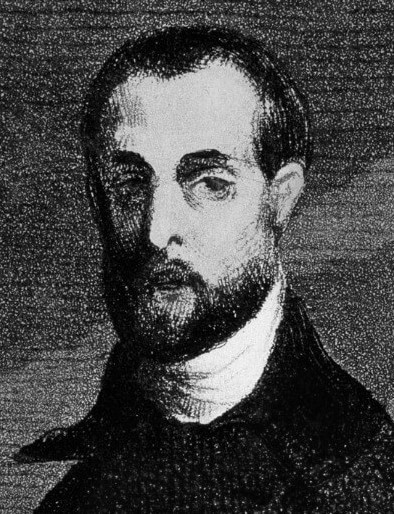
In Paris there are two dens, one for thieves, the other for murderers.
The den of thieves is the Stock Exchange; the den of murderers is the Courthouse.
— Petrus Borel
7 notes
·
View notes
Text

PETRUS BOREL
BOREL PIERRE-JOSEPH D' HAUTERIVE dit PÉTRUS (1809-1859)
Champavert, contes immoraux. Paris, Eugène Renduel, 1833. In-8, maroquin rouge, triple filet, dos orné, dentelle intérieure, tranches dorées sur marbrure (Canape).
Très rare édition originale de cet ouvrage recherché. Ce recueil de 6 nouvelles truculentes, horribles et cruelles est l’une des oeuvres les plus typiques de l'esprit du « Lycanthrope ».
"La pluie tombait à flots, le tonnerre mugissait, et quand les éclairs jetaient leurs nappes de flammes sur la plaine, on distinguait Flava, échevelée ; sa robe blanche semblait un linceul, elle était couchée sous les touffes du houx. Champavert, à deux genoux sur terre, de ses ongles et de son poignard fouillait le sable. Tout à coup, il se redressa tenant au poing un squelette chargé de lambeaux : — Flava ! Flava ! criait-il, tiens, tiens, regarde donc ton fils ; tiens, voilà ce qu’est l’éternité !… Regarde !"
Chef de file de ceux que l'on désigne communément du nom de « petits romantiques français », boudé par le succès de son vivant, Pétrus Borel s'impose aujourd'hui comme l'un des écrivains les plus originaux du romantisme.
bibliorare.com
3 notes
·
View notes
Text
Il faut qu'un enfant jette sa bave avant de parler franc; il faut que le poète jette la sienne, j'ai jeté la mienne : la voici ! ... Il faut que le métal bouillonnant dans le creuset rejette sa scorie; la poésie bouillonnant dans ma poitrine a rejeté la sienne : la voici ! ...
#Petrus Borel
0 notes
Text

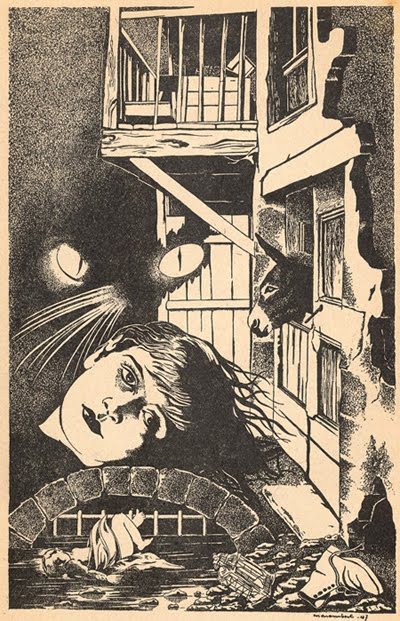
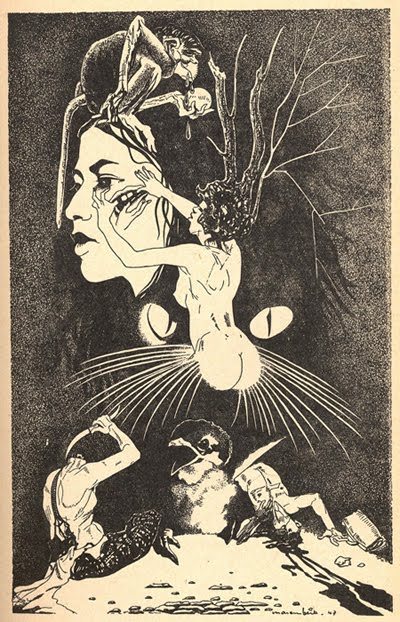

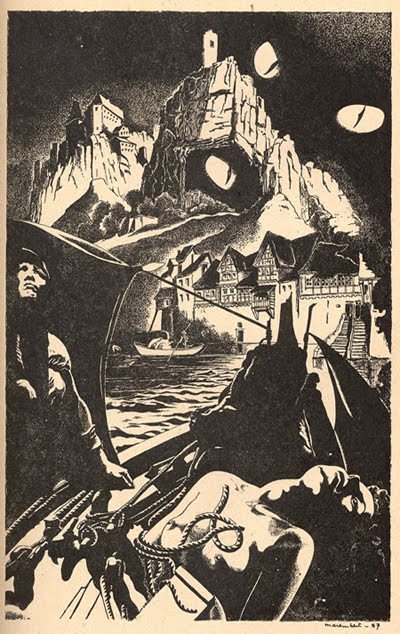
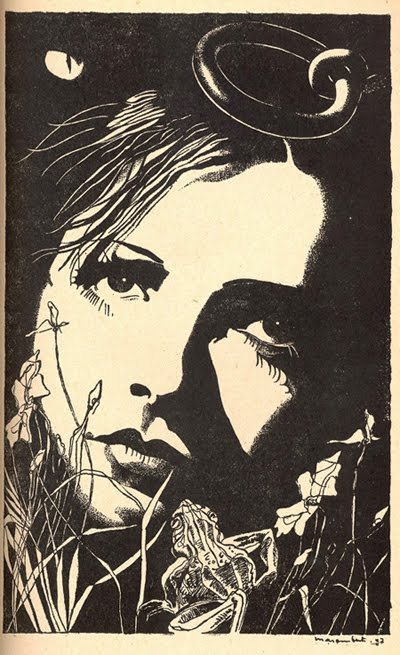
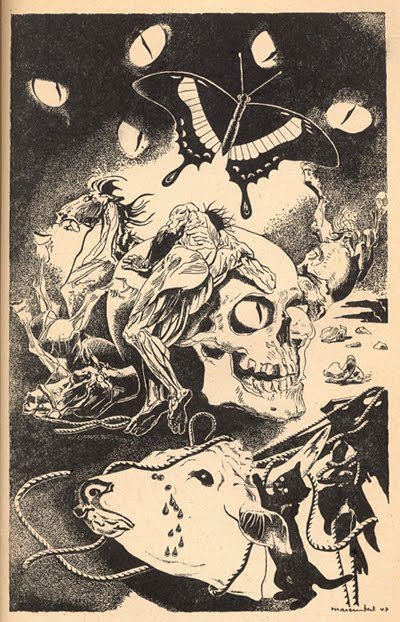
Jean Marembert Illustrations for Petrus Borel's Le Lycanthrope
Not much is known about french Surrealist Jean Marembert and even less is known about his illustration as he is mostly remembered for his painting. We do know that he was the cofounder of a surrealist circle with Louis Cattiaux and that he exhibited with Man Ray in 1958 and that he fought in World War II. None of these meagre biographic details are sufficent to shed any light on how an artist working in 1947 could formulate what we now recognize as a distinctly modern aesthetic graphic sensibility. One would think Marembert would be a big influence on american horror comics illustration in the fifties, with his stark distribution of lights and darks and his macabre visual vocabulary, yet I have never seen him cited as an influence in any pre-code horror comics history.
scans and text appendege blogspot 2010
375 notes
·
View notes
Note
Hi! Do you have any idea of the etymology of Les Amis’ names/French words that sound like their names?
I’m not an expert on this and someone else probably knows more! But here’s all I know off the top of my head. I’ll go from “ones that have canonical book explanations” to “ones that are vague or more speculative”:
Grantaire: His name sounds like “Grand R” or “big R” in French. As a result, he doesn’t sign his name with a normal signature but with a giant letter R. This is also why it’s a popular fan headcanon for “R” to be Grantaire’s nickname.
Lesgle/Bossuet—this is a pun but I’m still not completely sure I get it. So his name is “Lesgle,” which sounds like “l’aigle” (the eagle) and he comes from Meux. Unrelated to him there’s also a famous bishop who was known as “L’aigle of Meux,” whose real name was Bossuet. So les amis made a pun and Lesgle got the nickname Bossuet as a joke about the bishop.
Jehan Prouvaire— Jehan is obsessed with Medieval literature, so he added an “H” to his name “Jean” to make it more medieval.
Feuilly— sounds like the French word for paper, a nod to his work as a fan maker
Bahorel— sounds like “Borel,” like the name of one of Hugo’s friends Petrus Borel
Courfeyrac— comes from a wealthy family, and there’s a whole thing where he should go by “de Courfeyrac” because he’s upper class— but he refuses and just goes by plain Courfeyrac. Idk much about the origin of the name but it seems to me like it’s supposed to mark him as Wealthy— I guess it’s similar to being named something like “Thaddeus Winston the Third?”
Enjolras— is apparently a very strange uncommon-before-les-mis name that would come from Southern France, and even French people disagree on how to pronounce it (?)
Joly - I know nothing about this name except that his friends like to add extra Ls to it as a joke, I think?
Combeferre— I know nothing. This name is a mystery just like the character himself
Bonus:
Marius Pontmercy: Marius’s name is based on Victor Hugo’s middle name, “Marie.” And “Pontmercy” is the French word for “bridge” and then the French word for “thank you.” (I’ve seen fics with an English Marius named “Marius Thankbridge.”) The Pontmercy name pun is important because it’s why Thenardier never learns who Georges is; when Georges is struggling to tell him “my name is Pontmercy” all Thenardier hears is “merci,” so he just thinks the man is just thanking him.
If anyone knows more, feel free to add on! : D
147 notes
·
View notes
Text


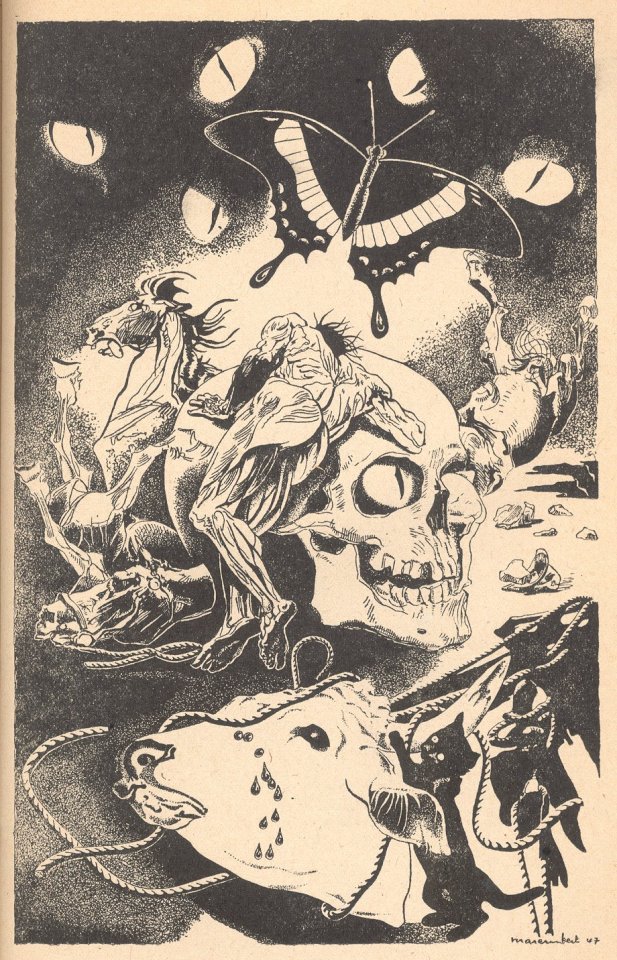
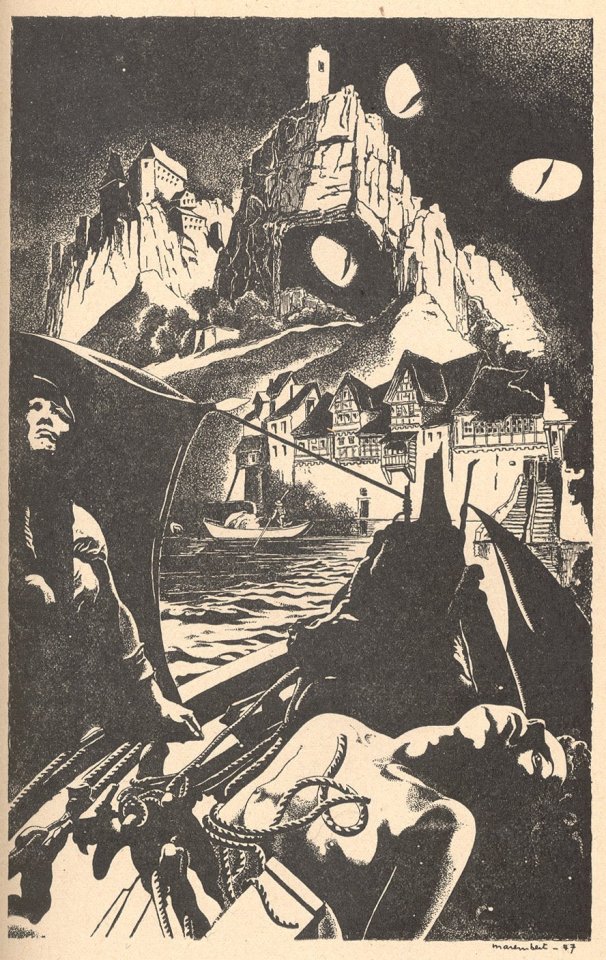


1927 by Jean Marembert for Petrus Borel’s 1927 edition, Champavert, contes immoraux
1 note
·
View note
Text

Como ya tengo 44 años, voy a dar algunos consejos sobre el arte de escribir cuentos.
1. Nunca abordes los cuentos de uno en uno. Honestamente, uno puede estar escribiendo el mismo cuento hasta el día de su muerte.
2. Lo mejor es escribir los cuentos de tres en tres, o de cinco en cinco.
Si te ves con energía suficiente, escríbelos de nueve en nueve o de quince en quince.
3. Cuidado: la tentación de escribirlos de dos en dos es tan peligrosa como dedicarse a escribirlos de uno en uno, pero lleva en su interior el mismo juego sucio y pegajoso de los espejos amantes.
4. Hay que leer a Quiroga, hay que leer a Felisberto Hernández y hay que leer a Borges. Hay que leer a Rulfo, a Monterroso, a García Márquez. Un cuentista que tenga un poco de aprecio por su obra no leerá jamás a Cela ni a Umbral. Sí que leerá a Cortázar y a Bioy Casares, pero en modo alguno a Cela y a Umbral.
5. Lo repito una vez más por si no ha quedado claro: a Cela y a Umbral, ni en pintura.
6. Un cuentista debe ser valiente. Es triste reconocerlo, pero es así.
7. Los cuentistas suelen jactarse de haber leído a Petrus Borel. De hecho, es notorio que muchos cuentistas intentan imitar a Petrus Borel.
Gran error: ¡Deberían imitar a Petrus Borel en el vestir! ¡Pero la verdad es que de Petrus Borel apenas saben nada! ¡Ni de Gautier, ni de Nerval!
8. Bueno: lleguemos a un acuerdo. Lean a Petrus Borel, vístanse como Petrus Borel, pero lean también a Jules Renard y a Marcel Schwob, sobre todo lean a Marcel Schwob y de éste pasen a Alfonso Reyes y de ahí a Borges.
9. La verdad es que con Edgar Allan Poe todos tendríamos de sobra.
10. Piensen en el punto número nueve. Uno debe pensar en el nueve. De ser posible: de rodillas.
11. Libros y autores altamente recomendables: De lo sublime, del Seudo Longino; los sonetos del desdichado y valiente Philip Sidney, cuya biografía escribió Lord Brooke; La antología de Spoon River, de Edgar Lee Masters; Suicidios ejemplares, de Enrique Vila-Matas.
12. Lean estos libros y lean también a Chéjov y a Raymond Carver, uno de los dos es el mejor cuentista que ha dado este siglo.
Consejos para escribir cuentos de Roberto Bolaño
0 notes
Text
It’s almost Yuletide! This will be my 18th Yuletide! My first Yuletide story will be old enough to vote this year and I have some mixed feelings about that! But also I have never missed or defaulted on a Yuletide since, and I have to say I feel pretty proud of that.
I am still pretty far down the Les Misérables rabbit hole (speaking of which, it is not too late to propose programming for Barricades!), and unsurprisingly all the fandoms I'm nominating/requesting this year are set in July Monarchy France--Les Mis canon era: Petit-Cénacle RPF,
Champavert: Contes Cruelles | Champavert: Immoral Tales - Pétrus Borel, and Les Enfants du Paradis | Children of Paradise.
Petit-Cénacle RPF
The Petit-Cénacle was a French Romantic salon, slightly younger and considerably more politically radical than the Cénacle centered on Hugo and Dumas; it included painters and sculptors as well as writers and critics, and most of its members at least dabbled in both written and visual arts. Its best-known members today are Théophile Gautier, Gérard de Nerval, and Pétrus Borel (the Lycanthrope)--the last two are thinly fictionalized in Les Misérables as Jean Prouvaire and Bahorel. (It's debatable how much Grantaire owes to Gautier but it's probably a nonzero amount.)
The group coalesced around Borel and Nerval as the organizers of the Battle of Hernani--a fight between Romantics and classicists at the premiere of Victor Hugo's play Hernani in 1830. Most theater productions at this time had claques--groups of paid supporters of a show or an actor, who were planted in the audience to drum up applause. For Hernani--the first Romantic work staged at the prestigious Comédie-Français, which broke classical norms so thoroughly that it no longer seems at all transgressive--Hugo and the theater management decided they were going to need more than just a claque. They recruited a few of Hugo's fans--Gautier was so star-struck he had to be physically hauled up the stairs to Hugo's apartment--to stage An Event. The fans recruited their friends. They showed up in cosplay, with the play already memorized and callback lines devised. It was basically the Rocky Horror Picture Show of its day. It almost immediately turned into an actual fight, with fists and projectiles flying. And it made Hernani the hottest ticket in Paris.
This is the group's origin story, and they pretty much spent their lives living up to it. They were every bit as extra as you would expect--Nerval allegedly walked a lobster on a leash in the Champs-Elyseés, explaining that "it knows the secrets of the deep, and it does not bark"--but they also stayed friends all their lives, often living together, supporting each other through poverty and mental illness and absurd political upheaval.
I'm nominating Pétrus Borel | Le Lycanthrope, Théophile Gautier, Gérard de Nerval, and Philothée O’Neddy; you could nominate other people like Jehan Duseigneur, Celestin Nanteuil, or the Deverias, or associates of the group like Dumas and Hugo.
The Canon
Gautier's History of Romanticism covers the early days of the group and the Battle of Hernani in some detail. (There is also a 2002 French TV movie, La bataille d'Hernani, which is charming and pretty accurate; hit me up if you want a copy.)
Other than that--this crowd wrote a lot, and they're all very present in their work--even in their fiction, which is shockingly modern in a ton of ways.
For Gautier, Mademoiselle de Maupin has a lot of genderfeels, surprisingly literal landscape porn, and a fursuit sex scene in chapter two.
If you want Nerval's works in English, you might be limited to dead-tree versions, but I highly, highly recommend The Salt Smugglers, a work of metafiction that answers the question, "What if The Princess Bride had been written in 1850 specifically to troll the press censorship laws of Prince President Louis-Napoleon Bonaparte?"
Borel's experimental short story collection Champavert has a new and very good English translation by Brian Stableford and is also my next fandom :D.
Champavert: Contes Immoraux | Champavert: Immoral Tales - Pétrus Borel
Last year I requested Borel RPF but I decided this book was unfanficcable. This year, I am going to have a little more faith in the Yuletide community.
Champavert, available in ebook and dead tree form, is a weird as hell little book and probably the best thing I read last year. It's an experimental short story collection from 1830. Someone on one of my Les Mis Discords described it as "a collection of gothic creepypasta, but the author is constantly clanging pots and pans together and going 'JUST IN CASE you didn't notice, the real horror was colonialism and misogyny all along and i'm very angry about it!'"
And, yeah, pretty much that, with added metafictional weirdness, intense nerding about architecture and regional languages, and the absolute delight that is Borel's righteously ebullient voice.
Borel wrote for a couple of years under the name of The Lycanthrope, and though he kills the alter ego in this book, the name stuck, and would continue to be used by friends and enemies alike all his life. Pretty much everyone who met Pétrus agreed that 1) he was just ungodly hot; 2) he was probably a werewolf, sure, that makes sense; and 3) he was definitely older than he claimed to be, possibly by centuries, possibly just immortal, who knows.
But, like I said, he kills the alter ego in this book: it begins with an introduction announcing that "Pétrus Borel" has been a pseudonym all along, that the Lycanthrope's real name is Champavert--and that the Lycanthrope is dead and these are his posthumous papers, compiled by an unnamed editor; the papers include some of Borel's actual poems and letters, published under his own name. The final story in the collection is called "Champavert, The Lycanthrope," and is situated as an autobiographical story, following a collection of fictional tales--which share thematic elements and, in the frame of the book, start to look like "Champavert"'s attempts to use fiction to come to terms with events of his own life.
And that's probably an oversimplification; this is a dense little book and it's doing a lot.
The subtitle is Contes Immoraux. It's part of a genre of "contes cruelles" (and, content note for. Um. A lot), but it's never gratuitously cruel--it's very consciously interrogating the idea of the moral story, and what sort of morality is encoded in fables, and what it means to set a story where people get what they deserve in an unjust world where that's rarely the case.
I'm nominating the unnamed editor, Champavert, his friend Jean-Louis from the introduction and the final story, and Flava from the final story; you could also nominate characters from the explicitly fictional stories.
Les Enfants du Paradis | Children of Paradise
This is a film made between 1943 and 1945 in Vichy and Occupied France and set...somewhere?...around the July Revolution, probably, I'll get into that :D. There's a DVD in print from Criterion and quite possibly available through your local library system. (And it's streaming on Amazon Prime and the Criterion Channel.)
It's beautifully filmed, with gorgeous sets and costumes and a truly unbelievable number of extras, and some fantastic pantomime scenes. (On stage and off; there's a scene where a henchman attempts to publicly humiliate a mime, and it goes about as well as you would expect.)
"Paradise," in the title, is the equivalent of "the gods" in English--the cheap seats in the topmost tier of a theater. It's set in and around the theaters of the Boulevard du Temple--the area called the Boulevard du Crime, not for the pickpockets outside the theaters but for the content of the melodramas inside them.
The story follows a woman called Garance, after the flower (red madder), a grisette turned artists' model turned sideshow girl turned actress turned courtesan, and four men who love her, some of whom she loves, all of whom ultimately fail to connect with her in the way she needs or wants or can live with.
This sounds like a setup for some slut-shaming garbage. It's not--Garance is a person, with interiority, and the story never blames her for what other people project onto her.
Of those four men, one is a fictional count and the other three are heavily fictionalized real people: the actor Frédérick Lemaître, the mime Baptiste Deburau, and the celebrity criminal Lacenaire. Everyone in this story is performing for an audience, pretty much constantly, onstage or off: reflexively, or deliberately, or compulsively.
Garance's survival skill is to reflect back to people what they want to see of themselves. She never lies, but she shows very different parts of herself to different people. We get the impression that there are aspects of herself she doesn't have much access to without someone else to show them to. Frédérick is also a mirror, in a way that makes him and Garance good as friends and terrible as lovers--an empty hall of mirrors. He's always playing a part--the libertine, the artist, the lover--and mining his actual life and emotions for the sake of his art. Baptiste channels his life into his art as well, but without any deliberation or artifice--everything goes into the character, unfiltered. It makes him a better artist than any of the others will ever be, but his lack of self-awareness is terrifying, and his transparency fascinates Garance and Frédérick, who are more themselves with him than with anyone else. Lacenaire, the playwright turned thief and murderer, seems to no self at all, except when other people are watching. Against the performers are the spectators: the gaze of others--fashion, etiquette, and reputation--personified by Count Mornay; and the internal gaze personified in Nathalie, an actress and Baptiste's eventual wife, who hopes that if they observe the forms of devotion for long enough the feeling will follow.
The time frame is deliberately vague--it's set an idealized July Monarchy where all these people were simultaneously at the most exciting part of their careers. In the real world, Frédérick turned his performance of Robert Macaire into burlesque in 1823, Baptiste's tragic pantomime Le Marrrchand d’Habits! ("The Old-Clothes Seller") played in 1842, and Lacenaire's final murder, for which he is guillotined, is 1832; these all take place in Act II of the movie within about a week of each other.
(Théophile Gautier, mentioned but tragically offstage in the film, was a fan of Baptiste; Le Marrrchand d’Habits! started as Gautier's fanfic--he wrote a fake review of a nonexistent pantomime, and the review became popular enough the Theater des Funambules decided to actually stage it. It only ran for seven performances.)
I am nominating Garance, Frédérick Lemaître, Baptiste Deburau, and Pierre François Lacenaire. You could nominate any of the other characters (Count Mornay, Nathalie, the old-clothes seller Jéricho, Baptiste's father, his landlady, Nathalie's father the Funambules manager). Gautier, regrettably, does not actually appear in the film but you can bet that's going to be one of my prompts.
So, that's one good movie you definitely have time to watch before signups, several good books you probably have time for and that are probably not like whatever else you're reading right now, and one RPF rabbit hole to go down! Please consider taking up any or all of these so that you can write me fanfic about Romantic shenanigans.
#yuletide#crosspost from Dreamwidth#petit-cenacle#champavert#children of paradise#les enfants du paradis#petrus borel
5 notes
·
View notes
Photo

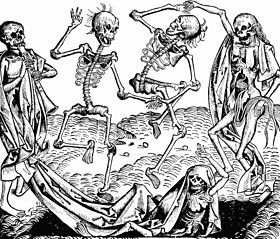




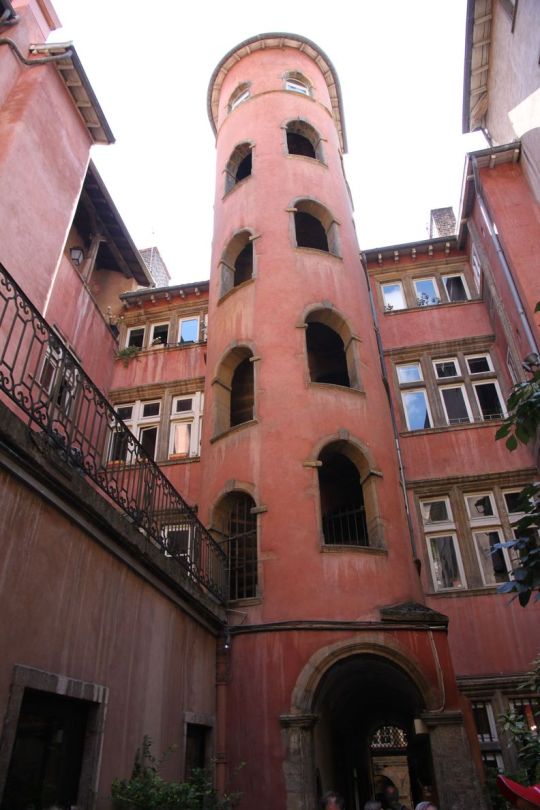



a memey Petrus Borel moodboard, for four people and a shoelace but especially for @aflamethatneverdies and @midautumnnightdream
Images, in order:
1-signboard saying “ Your Pretty Face is Going to Hell” in all caps
2-woodcut of dancing skeletons
3-sculpture of Wolves chilling against a wall, one reading a book
4- text post of (presumably an ask) reading “ you LITERALLY glorify toxic relationships, cannibalism, and hyperviolence! You may have fooled other people but all your souls are black and TAINTED! It’s disgusting! No morals! Stop acting all high and mighty, what you watch isn’t art, it’s FILTH. Fuck you and your little cannibal friends, you’re all DISGUSTING.”
the response reads: “reblog if your soul is black and tainted, you have no morals, and are disgusting”
5- text post reading “ I admire the betta fish because I also am beautiful and wish to fight everyone.” A reblog adds “ also people keep giving me inadequate living conditions and expecting me to flourish in it without complaint”
6-Maurice Sand’s illustration of werewolves leaning against the wall outside a town
7- the Tour Rose of Lyon, a historical building. No Other Comment. (source: Wikimedia
8- a medieval well , photo by Blaise Laustriat on Wikimedia
9- Comic panel of a werewolf saying “ it’s going to get weird. I’m going to make it weird.”
10 text post reading “ I think people who have been wronged by society can destroy said society, as a treat “
#Petrus Borel#Four People and a Shoelace#I may have transcribed that super long one a little wrong but. I Tried.
27 notes
·
View notes
Text
(…) Petrus, éventrant le paquet, en tira une chevelure, la roula sous son pouce couleur d’or bruni dans la petite feuille de papel de hilo, l’alluma à la chandelle plantée dans une bouteille vide, et la porta à ses lèvres avec une visible expression de plaisir bien rare sur sa figure stoïque. Ses grands yeux hispano-arabes brillèrent un instant, une légère rougeur se répandit sous le tissu olivâtre de sa peau, des jets de fumée blanche lui sortirent alternativement des lèvres et des narines, et bientôt il disparut à demi dans le vaporeux tourbillon, pareil à Jupiter assembleur de nuages.
Théophile Gautier, Histoire du Romantisme
#well this is just#… very nice#just basking in his beauty and pleasure#french romantics#theophile gautier#petrus borel#reference
20 notes
·
View notes
Text
Okay, I’m still losing it over Champavert.
But like
The idea of an immoral fable is a joke?
Because fables were a morally horrible genre to begin with?
They imagine the world as just--but understanding that the world isn’t just is a prerequisite for being a decent human being. And they focus morality on individual virtue/vice and individual reward--and away from the ways systemic oppression creates the context for a lot of individual harms.
So Champavert fixes it.
It’s a set of “fables” that keep wrenching attention away from individual actions back to the context of systemic oppression that individuals are acting in. People are bad, people are good--doesn’t matter, the system crushes the people whom the system was built to crush. Stop looking at individual crimes and catastrophes and look instead at the system that’s promoting and abetting them.
I really, really think the joke is that this is the only possible moral version of a fable.
#i feel like i've had this thought before?#about the moral bankruptcy of fables and what it would take to fix it#but borel actually DID it#petrus borel#omg you brilliant madman werewolf
23 notes
·
View notes
Text
Reading Le Gniaffe is like, I sure did not understand many of the jokes/puns/references Petrus is making but wow I understood him being super annoyed and poking fun at the shoemaker who has gotten as rich as a bourgeois by shipping sub standard shoes to France's colonies so much that he felt the need to write a whole story around that.
....I did not expect that. And yet I feel I should have.
#when your history fave has never any chill ever#the violence inherent in the system#petrus borel#French Romantics#I finally made my way through it#and he poked fun at Hugo's fivehead too which is also something I was not expecting#but also enjoyed#sorry Hugo
17 notes
·
View notes
Text
everytime Borel quotes one or his friends or is referencing something related to them I.... :’)
4 notes
·
View notes
Text
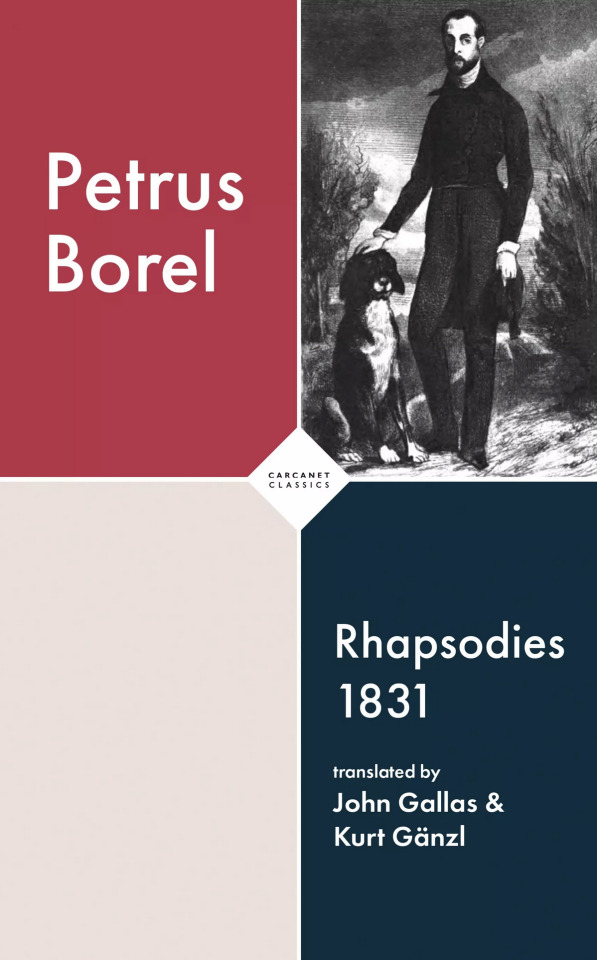
This month Carcanet published a translation of Petrus Borel's Rhapsodies 1831, a collection of poems from his twentieth and twenty-first years. "The poems, he said, are 'the slag from my crucible': 'the poetry that boils in my heart has slung its dross'."
In the Anthology of Black Humor, Andre Breton described his Champavert as a "livre sans équivaut, mystification lugubre, plaisanterie d'une terrible imagination" [book without equivalent, lugubrious mystifcation, joke of a terrible imagination] and his Madame Putiphar as an "ouvrage traversé d'une de plus grands souffles révolutionnaires qui furent jamais" [a work breathing with one of the greatest revolutionary spirits that ever was].
0 notes